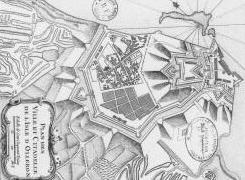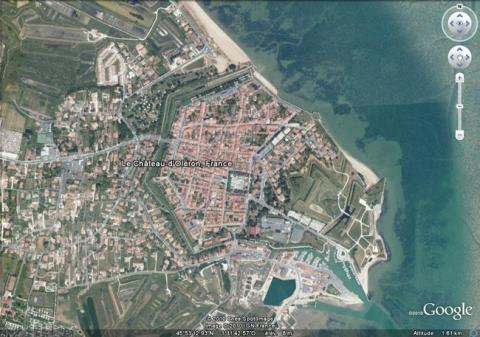Château d’Oléron
History and description
A medieval town and main agglomeration of the island of the same name, the first fortifications and castle were built in Château d’Oléron in the 10th century, by the Dukes of Aquitaine. Around 1630, Richelieu ordered the construction of the current citadel, slightly to the east of the former castle, which disappeared. The construction, directed by the engineer d’Argencourt, lasted eleven years and finished shortly after the death of the cardinal. When Louis XIV ordered the creation of Rochefort, the site of Oléron was retained as an advanced site for the defence of the new port arsenal. Colbert sent the Knight of Clerville to modernise the defences, which were no more than a citadel with a urban wall with projections and small curtain walls. The engineer Combes proceeded with constructions following the death of Clerville up until 1688. Subsequently, he was replaced by Ferry, a close colleague of Vauban.Ferry, who worked on the designs of Vauban, razed part of the urban wall from the Richelieu period and constructed two hornworks, one facing the town and equipped with a ravelin, and the other in front of the marshes. Around 1690, another ravelin was build and the covered walkways and glacis were completed five years later. The urban wall of the town was subsequently modernised, but the construction remained incomplete.
In 1741 and 1742, the façade of the main gate and the sleeping bridge were restored. In 1758, the swoop of the English during the Seven Year war prompted French Military Engineering experts to reinforce the defences on the coast of île d’Aix.
Current state
The citadel and ramparts remain and can be visited. The citadel has been restored on two occasions: the first in 1959-1970, following the bombardments of 1944-1945; the second in 1988, in order to repair the damage caused by it having been abandoned since 1970. The relief map of 1703, restored in 1772, 1828 and 1920 is preserved at the musée des Plans reliefs of Paris and shows the aspect of the fortifications at the Vauban period to be documented. Oléron is only of minor interest for his work, as a site that was modified. Nevertheless, it bears witness to the French bastioned fortification under Louis XIII, as well as the work of the Knight of Clerville, Vauban’s immediate predecessor.
Château d’Oléron
Château d’Oléron
45° 53' 11.8115" N, -1° 11' 43.1884" E
Type
citadel, urban wall and town planning
Engineers
Pierre de Conty d’Argencourt, Louis-Nicolas de Clerville, Benjamin de Combes, Sébastien le Prestre de Vauban, François Ferry
Department
Charente-Maritime
Region
Nouvelle-Aquitaine
Bibliography
- FAUCHERRE (N.), Bastions de la mer. Le guide des fortifications de la Charente-Maritime, Chauray-Niort, 1994.
- LE BLANC (F. Y.), FAUCHERRE (N.), La route des fortifications en Atlantique, Paris, 2007.
- WARMOES (I.), Le musée des plans-reliefs, Paris, 1997, p. 58.
- AUTISSIER (A.), GISSINGER (B.). Le logis du Gouverneur d’Oléron au sein de la citadelle de Château d’Oléron : histoire et archéologie, Revue Historique du Centre-Ouest, XIII, Poitiers, 2015, p. 163-203.

